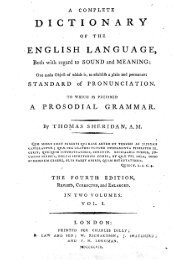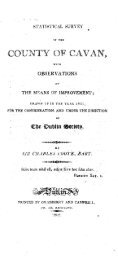extent of the Poll, and the rather arbitrary method of its determination,was duly taken advantage of by the unscrupulousCommissioners and purposely complicated in the interests ofthe Planters who had obtained grants of lands in Ulster. Theadoption of the so-called " Irish Plantation Measure "-whichstill survives in Co. <strong>Cavan</strong>-at a somewhat later period and forthe same purpose is a familiar fact of history.The Poll and its sub-divisions, the Gallon, Pottle and Pint,enter largely into the placenames of Co. <strong>Cavan</strong>. The followinginter-relations have been established :1 Poll = 2 Gallons = 4 Pottles = 8 Piqzts.The opening paragraph of the 1609 Inquisition specifies clearlythe relations existing between these ancient land measures. ThePint, however, does not enter so frequently into placenames asdo the larger divisions ; as " point," it forms a few terminations.In 1699 the Carvaglt, which consisted of, approximately, 35acres, was adopted as the unit of taxation in Co. <strong>Cavan</strong>. Thewhole County was estimated to contain 8,000 Carvaghs, averaging1,000 per Barony for 8 Baronies-Loughtee being regarded as two,Upper and Lower. Tullyhaw was reckoned as 5514 Carvaghs ;Loughtee Lower, 9246 ; Loughtee Upper, 1,7764 ; Tullyhunco,701i ; Clanmahon, 9164 ; Clankee, 874 ; Tullaghgarvey, 1,498 ;Castlerahan, 757i. The mode of applotting the Carvaghs wasdetermined by Act of Parliament, and the system was an intricateone. The Carvagh system was, as far as I have been able toascertain, peculiar to Co. <strong>Cavan</strong>, where it survived until thebeginning of the 19th century. But the Carvagh was a taxationunit rather than a unit of measurement. The word " carvagh,"signifying a share, still survives in the popular idioms of <strong>Cavan</strong>speech, also in some townland names.The mediaeval system of tithes devised for the support of thesecular clergy is clearly illustrated in the statement of the 1609Inquisition. It will be observed that the tithes were paid bothin money and in kind. Payments were generally made in marks,or fractions of a mark ; the mark was value 13s. 4d. in the moneyof the time. Besides money payments it may be noted that payment,or partial payment, was also made in " breads " (i.e. loaves)," beefs " (i.e. cattle), butter, and the labour of workmen. Twothirdsof the tithes were paid to the parson (i.e., the parish priest)and one-third to the vicar (i.e., the curate). Attached to thercsidence of the parson was a division of land, called glebe-land.for his personal support. In all the larger parishes there werechapels of ease with termon lands attached. Special provisionwas made for the repair of the churches and certain passages in theInquisition make it abundantly clear that the secular clergy andthe Erenachs-the lay superintendents of the parochial property-were to maintain their own parish churches at their own chargeand out of the revenues of their own benefices and termon lands.
But that the parishioners usually gave voluntary help is alsospecifically stated. The proxies were usually paid to the Bishopin coin.The system of obligatory tithes was universally recognisedin the Middle Ages and the practice only ceased in Ireland whenthe confiscations of the 16th century deprived the Church of itsproperty and diverted its revenues into other channels. Fromthe information which is furnished by the Inqhisition we mustinfer that every parish provided a regular income for the maintenanceof its clergy. The cost of living was then comparativelylow and the purchasing power of money was very great. It isscarcely possible now to deduce the comparative values of themoney in circulation in those times, but it may be remarked thatin England in 1378 the Archbishop of Canterbury consiciered asalary of five marks a year adequate for a chaplain.The churches appear to have been generally maintained ingood repair, and the 16th century witnessed the restoration ofmany churches and abbeys. It was an age of church-building andrestoration, and many of our ancient churches, now in ruins,belong to that period. In 1427 Pope Martin V granted an Indulgence,under certain prescribed conditions, to all who shouldassist in the repair of the church of Holy Trinity Priory, LochUachtair. The entries in the Papal Annates enable us to understandmore clearly the status of the clergy and the general schemeof ecclesiastical administration in the 15th and 16th centuries,that is, auring the centuries preceding the Inquisition.In the great majority of the <strong>Cavan</strong> parishes two-thirds of thetithes were paid to either of the great Abbeys of Ceanannus (Kells)or Fore, in Meath Diocese, to which these parish churches belonged.From the statement of the Inquisitiolz we are furnishedwith elaborate details of the revenues paid from the <strong>Cavan</strong>churches to these Abbeys, and especially to that of the Fore. Asearly as the year 1306 the revenues of the Bishop of Kilmoreamounted to 10 marks while the revenues accruing to the Abbeysof 'Ceanannus and Fore, from lands and property in KilmoreDiocese, amounted to 6 and 11 marks, respectively. The Priorof Drumlane received the comparatively small sum of 3 marks,and the rector of Annagh a similar amount. The Inquisitiolz of1609 indicates in detaiI the revenues of the several pariskchurchesand, in practically every case, specifies the particular Abbey-Ceanannus, Fore, or Drumlane- of which tbe church was a dependency.The parish churches in the eastern part of Co. Cav<strong>anb</strong>elonged mostly to Ceanannus, as did also a few in tbe extremewest, e.g. Killinagh, as well as Killesher in Co. Fermanagh. Butthe great majority belonged to Fore.The origin of these payments from the parish churches ofancient BreLfIne to the two great Abbeys of Meath must be soughtfor in the early centuries of Christianity in Ireland when the
- Page 5 and 6: PAGEThe Cavan Inquisition of 1609 .
- Page 7 and 8: and the Report of this Inquisition,
- Page 9: present paper. For purposes of comp
- Page 13 and 14: TEXT OF THE INQUISITION.Finding-tha
- Page 15 and 16: coataining 4 ballibetaghs, the pars
- Page 17 and 18: arony of Tolcha :* Killnelynagh,f 2
- Page 19 and 20: etaghs and 1 poll, the parsonage im
- Page 21 and 22: allibetaghs in said barony, are par
- Page 23 and 24: Eniskine*, 2 polls, 3s. 4d. ; Killa
- Page 25 and 26: a pottle of land, parcel of said pa
- Page 27 and 28: if the corbe or herenagh, or any of
- Page 29 and 30: the sacraments and perform other sa
- Page 31 and 32: analysis of the records of the Iris
- Page 33 and 34: VICE-SOVEREIGNS,The first mention o
- Page 35 and 36: It is more than possible that it wa
- Page 37 and 38: Ballard-7 freemen and 1 burgess. Li
- Page 39 and 40: Year : . Date Elected :1779 June 28
- Page 41 and 42: Year: Date Elected :1762 June 28th1
- Page 43 and 44: Year : Date Elected :1708 { Jme 28t
- Page 45 and 46: 400Sear : Date Elected : Date Sworn
- Page 47 and 48: .Year : Date Elected : Date Sworn :
- Page 49 and 50: Year : Date Elected :June 27thJune
- Page 51 and 52: Year : Date Elected :1741 May 14th1
- Page 53 and 54: Year : Date Elected : Date Sworn :
- Page 55 and 56: Year : Date Elected :Date Sworn :Na
- Page 57 and 58: Year : Date Elected : Date Sworn :
- Page 59 and 60: \Year: Date Elected : ' Date Sworn:
- Page 61 and 62:
i 416Year : Date Elected :1708 { Ja
- Page 63 and 64:
418BOROUGH OF CAVAN.---LIST OF M'EM
- Page 65 and 66:
Year : Names of Freemen :1755 The H
- Page 67 and 68:
The burial was located on a project
- Page 69 and 70:
ourhood of the present town of Ball
- Page 71 and 72:
discovered in 1932 were, in part at
- Page 73 and 74:
of Journal ; E. J. Smyth, Hibernian
- Page 75 and 76:
paper, which is a lengthy one, is r
- Page 77 and 78:
and that infinite variety and beaut
- Page 79 and 80:
Dublin, carrying 48 passengers, in&
- Page 81 and 82:
VERY REV. MICHAEL J. FLYNN. Rector
- Page 83 and 84:
thousands of extracts from the Chan
- Page 85 and 86:
Preiffne antiquarian anb Bis'torica
- Page 87 and 88:
FARRELLY, T.M. .. ...FIGGIS, W.F. .





